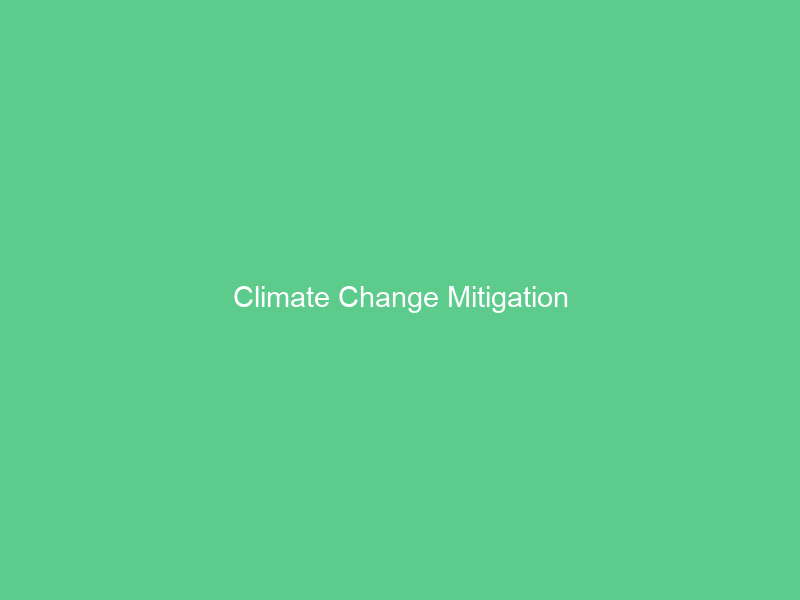Climate change mitigation refers to efforts taken to lower greenhouse gas emissions, both through preventing future releases as well as by extracting existing carbon dioxide from the atmosphere.
Research should focus on developing technologies for cost-effective energy end use efficiency and low carbon energy supplies. Furthermore, additional work needs to be done on modeling and assessment methodologies so as to provide greater insight into the costs and benefits associated with mitigation policy choices.
Local Governments
Local governments – such as cities, towns, counties and tribes — play a critical role in climate change mitigation. They usually conduct greenhouse gas inventories to identify sources of emissions before developing climate change action plans to lower emissions and prepare for any impacts that might result.
Local governments are taking proactive steps to mitigate environmental damage through legal means, including lawsuits against fossil fuel companies for environmental harm caused by their operations. Such suits seek damages for public or private nuisance, trespass and violations of consumer protection laws.
Local governments may form international partnerships with other local government institutions and stakeholders in order to take joint actions on mitigation. C40 Cities Network, for instance, a global coalition of mayors who aim to cut carbon emissions by half by 2050 is one example; ICLEI offers publications, webinars and toolkits specifically for developing comprehensive climate action plans in local government contexts.
Agriculture
Agriculture is a significant contributor of both carbon dioxide and methane emissions, so cutting back could play a pivotal role in mitigating climate change. Unfortunately, current practice of reporting CO2-equivalent reduction rates obscures which sectors contribute most to global temperature change.
Rising temperatures may benefit crop growth, but they also accelerate evapotranspiration and diminish available water resources, increasing drought, flood, heat stress, pest and other challenges to food production.
Farmers can utilize practices to lower their environmental impact, such as improving soil health by adding organic carbon back into the soil or planting cover crops. Implementation will require education, awareness-raising and incentives for farmers to adopt them; furthermore climate change mitigation efforts may cause trade-offs (e.g. reducing methane emissions may lead to an increase in nitrous oxide). It’s essential that any trade-offs are carefully managed as part of climate change mitigation plans and monitored effectively in order to achieve maximum impact from mitigation strategies.
Energy
Reduce greenhouse gas emissions by switching away from fossil fuels (coal, oil, natural gas) towards renewable energy sources such as solar, wind, geothermal and hydro power that produce significantly fewer of them – renewables such as solar power can include solar panels on rooftops; wind turbines; geothermal heat pumps and hydro power; with additional health co-benefits like reduced air pollution that contributes to early death or switching towards plant-based diets that help avoid diabetes and heart disease.
Goal of these efforts is to reduce heat-trapping greenhouse gas concentrations in the atmosphere by stabilizing them at less dangerous levels, although this remains difficult. But efforts have made significant strides forward, particularly in areas like renewable electricity generation and transport.
Transportation
Climate Change Mitigation in Transportation means minimizing human contributions to global greenhouse effects by decreasing emissions of heat-trapping gases and particles like black carbon (soot). Climate Change Adaptation refers to adapting transport services, equipment, routes and contingency plans in response to future changes.
Interviews conducted for this study demonstrated that companies in inland waterway transport, road freight transport, rail freight transport and CEP industries all place equal emphasis on climate protection measures; however, their efforts vary considerably when it comes to reducing GHG emissions. Operational costs and fluctuating energy prices presented major transitory risks for companies operating inland waterway vessels and road freight transport operations respectively.
Climate-induced damage to transport infrastructure can result in delivery delays and supply chain jams, endangering customer and employee safety as well as business viability. Companies operating within these sectors must devise effective adaptation strategies while encouraging public transit as a low carbon alternative which also offers evacuation during extreme weather events.

